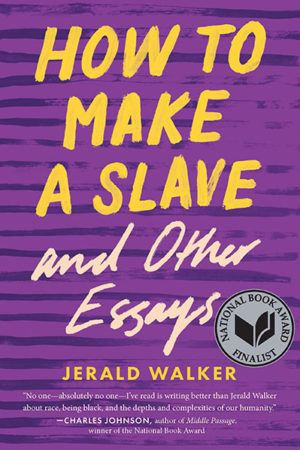How To Make A Slave and Other Essays
by Jerald Walker
reviewed by Caleb J. Gayle
Well-meaning people dedicate their lives to naming things, but perhaps one of the hardest things to name—and subsequently describe—is the experience of those who are marginalized by society. Usually, we try to find simple, linear stories, and choose over-generalized narratives instead of the messy, honest truth in attempts to describe the Black experience. But this often runs the risk of monolithically categorizing that experience. When taking on the task of explaining how one is made a slave, a linear, concise book cannot be written. It must be messy, composite, and complex. Written at multitudes, Jerald Walker’s book How to Make a Slave and Other Essays meets the challenge.
In this collection that received a finalist placement for the 2020 National Book Award for Nonfiction, Walker provides greater clarity for what it might mean to be a Black man in America by dismissing the linearity and simplicity that naming Blackness often produces. We cannot be surprised by the clear, yet complex, multitudinous approach Walker takes—in part, the book is dedicated to James Alan McPherson, who encouraged Walker as a student to complicate how he wrote about Black folks and Black folks’ lives. McPherson was Walker’s professor while Walker studied at the Iowa Writer’s Workshop, and Walker remembers an important and challenging moment with McPherson in the essay “Dragon Slayers,” which sheds light on his writing style today.
On the day that his writing was up for critique in workshop, Walker—like many writers in the same position—awaited his peers’ feedback nervously. Instead, that day McPherson chimed in himself. Discussing Walker’s piece with the class without naming Walker as its author, McPherson states of its protagonist: “This person raps about the ghetto [ … ] but he doesn’t live in the ghetto. He lives in a wealthy white suburb with his wife and daughter. His daughter attends a predominantly white, private school.” Stunned, Walker, who truly did grow up in the “ghetto,” listens as McPherson’s critique grows sharper: “What some gangster rappers are doing is using black stereotypes because white people eat that stuff up. But these images are false, they’re dishonest. Some rappers are selling out their race for personal gain [ … ]. That’s what this writer is doing with his work.”
Walker shows us just how irate and righteously indignant he became, only for McPherson to continue and provide him with a lesson that all writers need to hear: “Stereotypes are valuable [ … ] But only if you use them to your advantage. They present your readers with something they’ll recognize, and it pulls them into what appears to be familiar territory, a comfort zone. But once they’re in, you have to move them beyond the stereotype. You have to show them what’s real.” When Walker asks what is real, McPherson replies succinctly, but with a difficult, implicit challenge: “You.”
The task of the memoirist—and the particular challenge for writers like Walker, like me, writers of color—is to offer the reader pathways to an authentic understanding of who we are. This can mean acceding to stereotypes, or radically abandoning them. Rarely does it involve some straight path that is both smooth and clear. No, the task, which Walker accomplishes deftly, is to guide readers through the messy compilation of experiences that shape “you.”
Walker’s voice isn’t gracious, but it is graceful and clear, never sparing the reader from the critical perspective that will help them unpack and deconstruct his experiences. In the essay “Balling,” Walker uses the crossover move, and the stereotype of the supposedly preternatural basketball skills of Black folk, to demonstrate that our lives and experiences are built on the basis of improvisation. In “Unprepared,” Walker takes us on an unexpected drive with a man who repeatedly propositions Walker—even going so far as to expose himself to him, which forces him to interrogate his perspectives on sex and sexuality. In “Feeding Pigeons,” Walker takes his readers to a night of drunkenness that reveals the odd distinctions between platonic and romantic relationships with both men and women. Throughout its pages, the collection asks us to consider how our varied life experiences shape our identities.
With his push to give the reader who he truly is, Walker is able to meet the charge of the collection’s titular essay: to explain “how a man was made a slave” and “how a slave was made a man.” Not by appealing to the stereotypes that his childhood might have given him the opportunity to do, but by giving people the “you” that McPherson asked for. It’s not neat, nor should it be. As he explains sex and sexuality, interpersonal interactions, love and loss, violence, alcoholism or addiction, we see Walker. With this literary feat, the potency of the Black monolith dies another death: a meaningful and required death.
Perhaps the responsibility we all have, Black or not, is to do what McPherson encouraged Walker to do. “Less time needs to be spent on the dragons,” as McPherson told Walker, the mega-problems that seem to typify the Black community as in a persistent struggle. Instead, let us spend “more on our ability to forge swords for battle and the skill with which we’ve used them.” This book is the ultimate testament to the fact that Walker has honed his skills, not by over-focusing on the dragons but instead by adeptly fashioning the tools to fight those dragons. We need to do the same.
Editor’s note: an essay published in How to Make a Slave and Other Essays, “The Designated Driver,” originally appeared in Harvard Review 50.
Published on February 9, 2021

